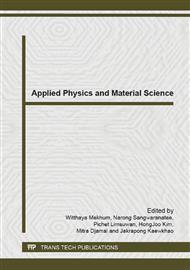p.3
p.7
p.11
p.16
p.20
p.23
p.27
p.31
The Transmittance to Direct Irradiance due to Absorption by Precipitable Water Vapor in the Atmosphere
Abstract:
This research aims to calculate the transmittance to direct irradiance due to absorption by precipitable water vapor in the atmosphere of Thailand, estimation of the absorptance by water vapor in the atmosphere and calculate the precipitable water vapor in the atmosphere. The precipitable water vapor in the atmosphere was calculated from upper air checking data relative humidity and temperature. The data were collected at four meteorological monitoring station located in Chiang Mai, Ubon Ratchathani, Bangkok and Songkhla during the years 1991-2010. The figures for precipitable water vapor obtained from this investigation were used to formulate a mathematical model relating to the precipitable water from four stations with surface climatological data, relative humidity and temperature at the same stations. The result showed that the relationship has a relatively high level of reliability. The precipitable water vapor obtained from upper air nearly is equal to the value from the model. The difference in the Root Mean Square Error (RMSE) is equal to 0.250 cm. Then, the researcher used a model to calculate the amount of precipitable water vapor at 85 meteorology stations nationwide. The result showed that the precipitable water vapor was less in the dry (November to March) and relative high in the rainy season (April-October). The average per year was found to be 4.559 cm. When analyzing the solar radiation absorption by water vapor in the atmosphere, found that the absorption is more or less depending on the precipitable water vapor in the atmosphere, which has an average annual as 15.53 percent. The transmittance to direct irradiance due to absorption average per year was found to be 84.51 percent.
Info:
Periodical:
Pages:
7-10
Citation:
Online since:
June 2014
Authors:
Price:
Сopyright:
© 2014 Trans Tech Publications Ltd. All Rights Reserved
Share:
Citation:


